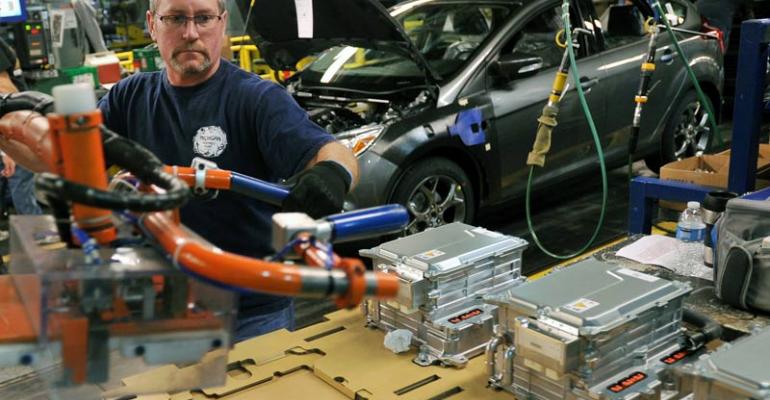WAYNE, MI – Ford celebrates the production launch of its C-Max Energi plug-in hybrid-electric cross/utility vehicle at the Michigan Assembly Plant here, a facility the auto maker says will serve as a blueprint for flexibility for its other manufacturing operations.
Converted from a plant that produced two fullsize SUVs, the Ford Expedition and Lincoln Navigator, Michigan Assembly now becomes the only factory in the world to build gasoline-powered, hybrid, plug-in hybrid and electric vehicles under one roof.
In addition to the C-Max Energi, the Focus, Focus ST, Focus electric and C-Max hybrid are made here. The electrified vehicles will make up about 25% of the plant’s annual volume, with the gas-powered vehicles accounting for the rest.
To accommodate production of the multiple-vehicle lineup, all of which share Ford’s global C-platform, the auto maker invested $550 million in the facility and in May added a third crew of 1,200 workers, bringing total employment to 5,170.
The plant, which has 604 work stations, operates on two shifts Monday through Friday and one shift on Saturday and Sunday.
James Tetreault, vice president-North America manufacturing, says the Michigan Assembly Plant workforce underwent an unprecedented amount of training to build multiple vehicles with different powertrains.
“A lot of these people have a complex flexible job (that) changes every time, and they’ve got to remember up to 10 elements that are different than the previous vehicle,” he tells WardsAuto at a media event here “It’s a definite training challenge to get everybody geared up to do that.”
Workers with basic jobs, such as installing windshield wipers, have not seen any change in their work requirements. But those who install components such as wiring harnesses, which differ between vehicle models, have been trained by product specialists.
Adding to the complexity, the 1,200 new workers are entry-level hires that fall under the new tier-2 wage system agreed to by the United Auto Workers union. Tetreault says many of the new hires had never worked in an assembly plant before and had to be trained on the basics, such as how to use workstation power tools.
Once classroom training was completed, workers practiced on prototype vehicles, building one a day. The line slowly is sped up and quality levels are checked to ensure the employee is up to the task.
When Ford began adding electrified vehicles to the mix at the plant, Tetreault says his team also had to determine by trial and error how many installation procedures a worker could handle. If an employee tasked with10 steps only was capable of nine steps, the 10th task had to be added to another workstation.
“We have an enormous board that lists every person and what training they need and when they are going to get it,” Tetreault says.
Of the 5,200 workers Ford has added to its North American workforce this year, about 4,800 are entry-level, he says, noting many are less than 25 years of age. This has resulted in lower North American manufacturing costs.
Although other Ford facilities may not have the degree of flexibility as Michigan Assembly, the factory still can serve as an example of how to plan for flexibility, Tetreault says. “Different plants will have different levels of flexibility. We’re not building hybrids in every plant.”
Producing multiple vehicles at a single plant allows Ford to better respond to consumer demand, reduce manufacturing costs and increase its capacity utilization, he says, noting the auto maker’s North American factories today are running at 114% capacity. “We don’t want to be trapped with dedicated ‘one-trick pony’ plants.”





